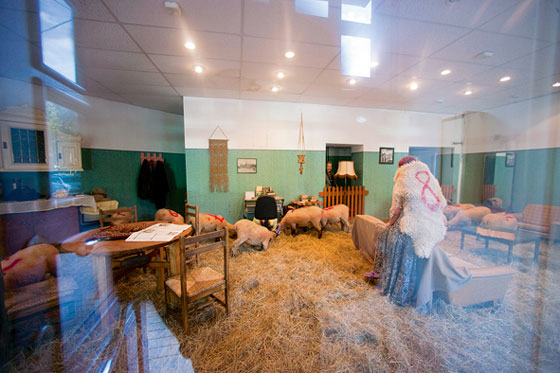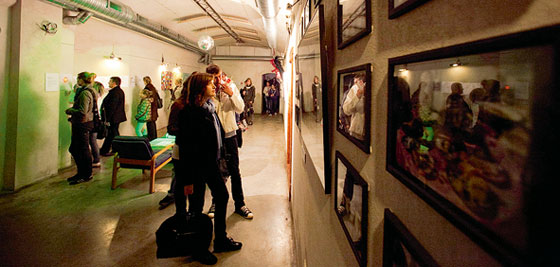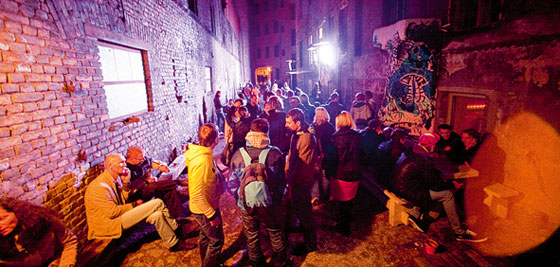|
|
| What’s really going on here? Pēteris Bankovskis, Art Critic Contemporary Art Festival Survival Kit 2 04.09.–11.09.2010. | |
| The Survival Kit 2 Contemporary Art Festival took place in Riga in September. It was organized by the Contemporary Art Centre. To those who may be withering away in “old-fashionedness”, in a limbo where English jargon isn’t used, and to those who don’t hold forth in popular TV “educational” channel mode, I will explain that Survival Kit means, let’s put it this way, a little suitcase or box, a package with the very essentials for survival. It has to be said that a person doesn’t really need all that much to survive. Those very same “educational” television broadcasts, Discovery, for example, shows how you can survive in the tundra, taiga or desert with very minimal resources: eating insects and grass, sleeping under a bush or in a snow cave. Well, in that vein. The reality of life in Latvia provides each of us with examples, if not always from our own experience then from the lives of our closest relatives, of how one can survive on the kind of pension, allowance or wage that Latvia’s budget permits. And there has never been any shortage of excellent examples of how to survive. For example, the people of my generation will certainly still remember the item in the newspaper about how Soviet sailors lost on the ocean survived for who knows how many weeks on next to nothing until they were rescued by the Americans. | |
 Aigars Bikše. A bloodcurdling show of truth and revelation 'Who's not a sheep here?'. Living installation. At the former Tourist Bureau at 10 Zigfrīda Annas Meierovica bulvāris. 2010. Photo: Didzis Grodzs | |
| But was Survival Kit 2 about that? Yes, they did organize some kind of mutual assistance, group support events there. For example, you could swap indoor plants, share folk remedy recipes, and even try to make friends with the neighbours in your street, apparently. However, you should be reminded that the organizer of the event was the Contemporary Art Centre – an institution which works to find out (perhaps even to understand and to spread the word to anyone else who is interested) what contemporary art is and what purpose it serves. To find out why there even is contemporary art (the products created by people who consider themselves to be artists, who “rate” in the relevant circles: at biennials, triennials, in the minds of curators and contemporary art museum directors and the magazines associated with them), or why it exists, is not at all easy. For today’s person, enveloped by a dense circle of material and non-material things, falling on top of one from supermarket shelves and from all sorts of “public space” devices, it is difficult enough. However burning the desire to acquire and consume may be, even those, the most numbed by mundaneness, during short moments of enlightenment may become fleetingly aware that all of this is rubbish, transitory rubbish. In the end a person, in their own biological hypostasis, is just a machine which processes products from the plant and animal world into you know what. All of the history of mankind’s “material culture”, as revealed by archaeology, is almost exclusively the history of rubbish. And here begins that tangle of contradictions. It is known that long ago, shall we say up to the middle of the 19th century, there also existed something which art historians call art. It existed in two forms. The first and most widespread, already from the time of the first cave-dwellers, was decoration – things were made to “look nicer”. That seems to be an inseparable component of the human condition, which in an old-fashioned way is called the quest for beauty. We won’t use words like ‘aesthetics’ or aesthesis here, otherwise we’ll sink into boundless neverending ponderings. Simply – to “look nicer”. From this impulse, that which we know today as “home culture”, “design” and much else has developed – and, of course, been corrupted to absurd excess. The second form of “art” was more practical. For people, at least for some, there has always been the need to ask why they and the world exist, and for what purpose. Truly, it is difficult to believe that only chaos and senselessness rule here, because if this were to be so, then people would have to admit that they, too, along with their families, children and homes are purely chaos and senselessness. Many, obviously, have thought about their circumstances and think just like this, nevertheless want meaning, cause and purpose. Yes, temples and icons are also beautiful; however, they aren’t created for beauty, but rather for the opportunity of asking the “great questions”, for the most important “discursive practices” of human beings. | |
 'Survival Kit 2' in 'Nabaklab'. 2010. Photo: Didzis Grodzs | |
| These two art directions, until the moment when a strange creation was created which we know by the name of ‘art museum’, crossed paths and got tangled up only to a certain degree. The museum threw everything into one pile, created art history, science, criticism, created the exhibition / salon, gallery, biennial–triennial–quadrennial, curator, art marketplace and – finally – contemporary art. It created a phenomenon, of which the greater part in material expression is, let’s be honest, worth rubbish (the “so it looks nicer” doesn’t even feature). The spiritual meaning – of icon and temple – is more complex. Today’s person, the artist as well, no matter what sort of fool he pretends or makes himself out to be, is only human. And he also gets to ask himself the question, why is it so, and what’s really going on here. However, the long centuries of “enlightenment” have made people self-righteous and conceited. The icon painter “used” his work only as a possible intermediary, to pass the really important questions on to God – creator and ruler of everything, but today’s artist thinks of himself as a little god, one who can dare to lambast others’ mistakes and offer plans to save the world. Nothing could be more pitiful and even warped than the often heard phrases that artist N in his work investigates this or that phenomenon, usually a social situation. They make you want to laugh, all these investigators. But you have to laugh and cry too about the way the word ‘artist’ is used. We’ve gone so far that, for example, a boy who has recorded a few flash-in-the-pan dance club tunes is already publicly declaring himself an artist. The Survival Kit Contemporary Art Festival made us ask the question whether is it possible to question. Doesn’t it become impolite to even try to explain what is and why there is art and / or the artist? Who knows, maybe this is the most important message that the festival brought us. And after the survival package, it is not the community created in “researchers’” minds which should strive the most for some kind of justification, but rather the “researchers” themselves, in this case – the “artists”. It is symptomatic that the part of the festival which reminded us most of the art exhibition we have been used to in recent years, as a sort of reflection of Venice, Kassel and similar, was to be found in the most “out of the way” place in the Survival Kit 2 system – in the bowels of the former VEF factory labyrinth of abandoned workshops. The quality of the works that were there is not important, even if you were to apply the kind of criteria which have been accepted in contemporary art. The emotional essence of Survival Kit is somewhere else completely: in “non-traditional places” and in “non-traditional communication”. | |
 'Survival Kit 2' in 'Nabaklab'. 2010. Photo: Didzis Grodzs | |
| Still, however non-traditional this communication may be, its content could also be interpreted as follows: there is this evil State, which “doesn’t give a toss”, and there are the good “artists”, all a younger generation of “creative” people. The latter would like to comprehensively unmask the State and to demystify it, but – with the State’s own funding and with its direct support. However, as the State doesn’t want to know about them, they end up having to “survive”, to pack their little survival suitcases – Survival Kits. At the VEF exhibition you could see that some young artists are preoccupied with worries about themselves: characteristically and occasionally even beautifully you could hear there such human questions about the transient and the lasting, about death, finally. In today’s individualistic era, alienated from the meaning of life, it is normal that such questions sound even naively simplistic. But, as I said before, it is unlikely that the VEF exhibition was meant to be a lesson on survival. However, I’d prefer to consider the “performance apartment” in Upīša pasāža as such a lesson. The people who were hanging around and working there will possibly be offended, but I will say that they were indulging in amoral, valueless nonsense. Yet for these necessities they manage to find funds for renting an apartment and to attract money and fellow participants from other countries. I turned up there during the day, at a time when no “performances” were taking place. On the walls you could examine photographs from previous rather idiotic events, but the international company of “performance artists” were busying themselves around the apartment with the typical seriousness of the current “project-writer” generation, obviously convinced that their activity had a purpose. /Translator into English: Uldis Brūns/ | |
| go back | |







